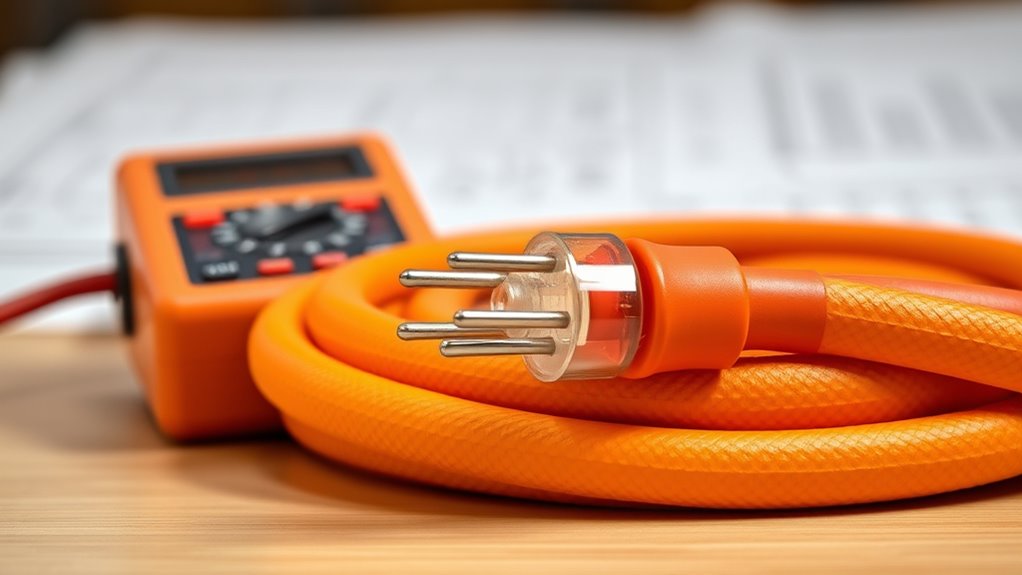Understanding voltage drop and extension cord sizing is key to keeping your devices safe and efficient. You need to consider factors like wire gauge, length, current, and resistance to ensure your cord can handle your power needs without losing voltage. Proper calculations help prevent overheating, damage, or fire hazards. By grasping these essential terms and formulas, you’ll know how to select the right cord. Keep exploring, and you’ll discover more ways to ensure safe, reliable power delivery.
Key Takeaways
- Proper extension cord sizing depends on wire gauge, length, and current to prevent voltage drop and safety hazards.
- Voltage drop is the reduction in voltage over distance, impacting device performance and safety.
- Calculating voltage drop involves the formula: Voltage Drop = 2 x Length x Resistance per unit length x Current.
- Thicker wire gauges (e.g., 10-12 AWG) reduce resistance and voltage drop over longer distances.
- Regular inspection, correct selection, and proper usage of extension cords ensure safety and optimal electrical performance.
Understanding Voltage Drop and Its Impact
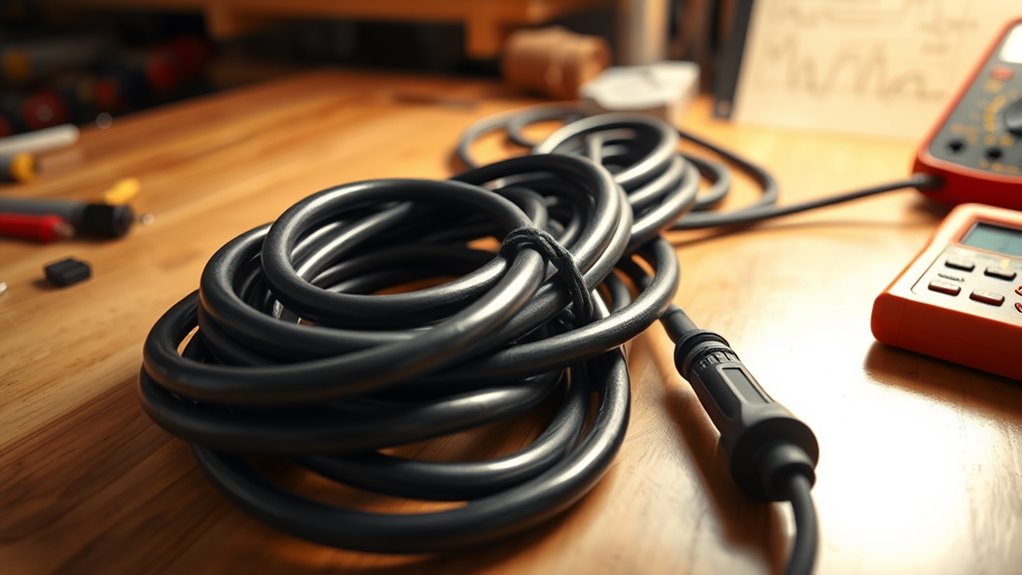
Understanding voltage drop is essential because it directly affects how well your electrical devices perform. When voltage drops below the required level, your equipment may malfunction or run inefficiently, risking damage. Voltage regulation ensures the power supply remains stable, but excessive voltage drop compromises this balance. Poor extension cord sizing or long cord lengths can cause significant voltage loss, jeopardizing electrical safety. By understanding how voltage drop works, you can choose the right extension cords and avoid hazards like overheating or electrical fires. Properly managing voltage levels helps maintain safe operation and prolongs your devices’ lifespan. Recognizing the impact of voltage drop empowers you to make smarter decisions, ensuring your electrical system stays reliable and safe during everyday use. Additionally, understanding how electricity transmission contributes to voltage drop can help you better assess potential risks and maintenance needs for your electrical setup.
Key Terms in Extension Cord Sizing
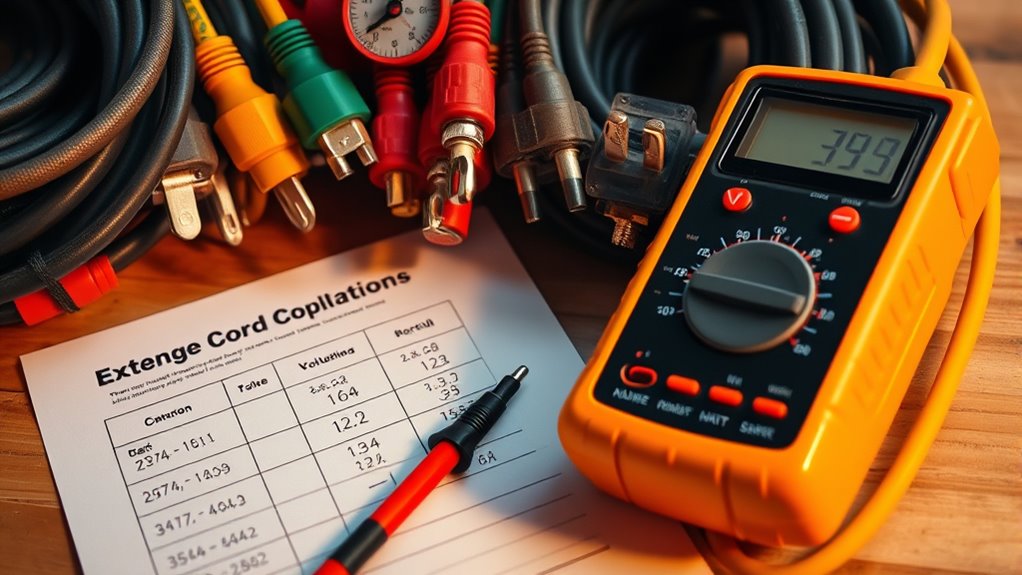
When selecting the right extension cord, knowing key terms related to cord sizing is essential to guarantee safety and performance. Two critical factors are wire gauge and cord length. Wire gauge indicates the thickness of the wire; a lower gauge means a thicker wire, which can carry more current safely. Cord length affects voltage drop; longer cords may cause more drop, reducing efficiency and safety. Understanding these terms helps you choose the proper cord for your needs, especially when considering heat pump installation where reliable power delivery is crucial.
The Role of Current and Resistance

Current and resistance are fundamental factors that directly influence how well an extension cord performs. The wire material, such as copper or aluminum, affects resistance—copper has lower resistance, allowing more current flow with less heat. Resistance causes voltage drop along the cord, which can reduce the efficiency of your connected devices. Insulation types also play a role; thicker or higher-quality insulation can limit heat buildup and prevent current loss. When more current flows through a wire with higher resistance, it heats up more, risking damage or failure. Understanding how wire material and insulation types influence resistance helps you choose cords that minimize voltage drop and maintain safe, reliable power delivery. Your choice directly impacts performance and safety during use.
Calculating Voltage Drop Step-by-Step

Calculating voltage drop step-by-step helps you determine how much voltage is lost as electricity travels through an extension cord. First, identify the wire gauge you’re using, since thinner wires have higher resistance, increasing power loss. Measure the total length of the cord, then find the current your device draws. Use the formula: Voltage Drop = (2 x Length x Resistance per unit length x Current). Resistance per unit length depends on the wire gauge; thicker wires have lower resistance. Multiply resistance by the cable length and current to find the voltage drop. If the result exceeds acceptable limits, you’ll know the cord can’t safely deliver power without excessive loss. This process guarantees you select the right wire gauge and cord length to minimize power loss and maintain safe operation. Additionally, understanding the contrast ratio can help you choose a projector that maintains image quality over longer cable runs.
How Wire Gauge Affects Power Delivery
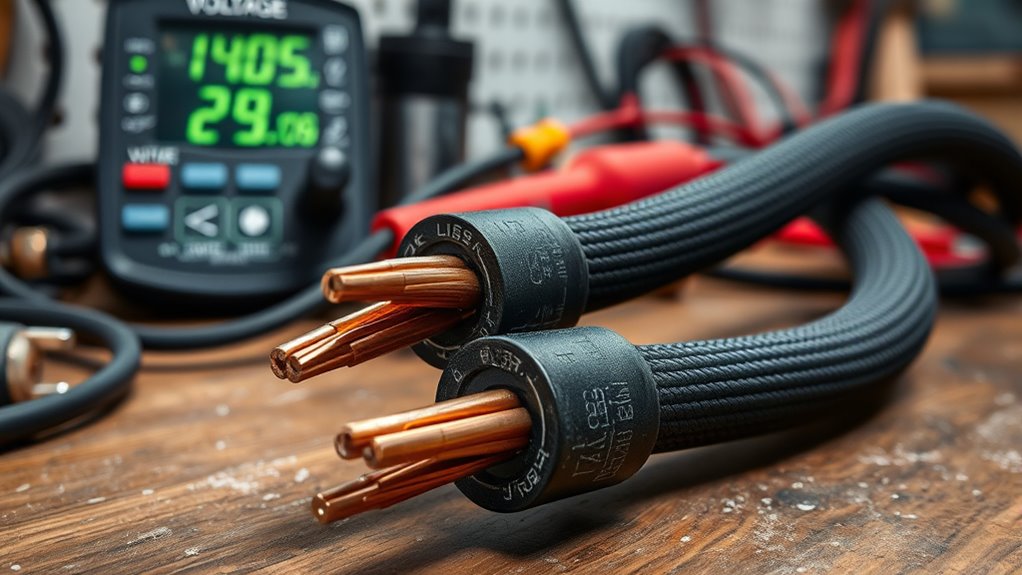
Choosing the right wire gauge directly impacts how effectively your extension cord delivers power. A thicker wire gauge (such as 10 or 12 AWG) allows more current to flow with less resistance, guaranteeing your devices receive adequate power. Conversely, a thinner wire gauge (like 16 or 18 AWG) increases resistance, which can cause voltage drops and reduce overall power delivery. When the wire gauge is too small for the load, it can lead to overheating or even damage to the cord. Proper gauge selection is crucial for maintaining efficient power delivery, especially over longer distances. By understanding how wire gauge influences resistance, you can choose the right extension cord to assure safety and excellent performance for your electrical needs.
The Importance of Length in Voltage Drop Calculations
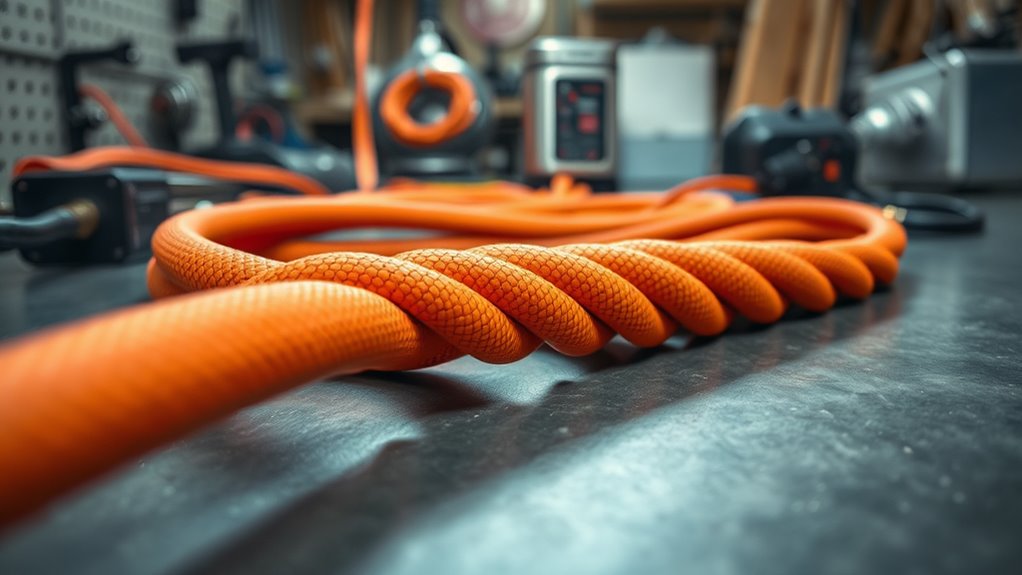
The length of your extension cord directly influences resistance and, in turn, voltage loss. As the distance increases, more voltage drops, which can impact device performance and safety. Understanding these factors helps you choose the right cord length and ensure safe wiring practices. Properly tuning your setup can also minimize voltage drop, similar to optimizing engine parameters in vehicle tuning to improve performance and efficiency engine tuning.
Resistance Increase Over Distance
As electrical current travels through an extension cord, resistance naturally increases with the length of the wire. The longer the cord, the more resistance you’ll encounter, which can lead to voltage drops. The type of wire material also impacts this resistance; copper wire has lower resistance compared to aluminum. Additionally, ambient temperature plays a role—higher temperatures cause the wire’s resistance to rise, further reducing voltage at the load. When planning your extension cord, consider both the length and the wire material, especially if you’ll be using it in hot environments. Longer cords with higher resistance can cause equipment to perform poorly or even get damaged. Understanding how resistance increases over distance helps you choose the right cord size and material to maintain safe and efficient operation. Proper Kia Tuning techniques can also optimize electrical systems in custom vehicle setups, ensuring reliable power delivery.
Voltage Loss Factors
Length plays a significant role in voltage loss when using extension cords. The longer the cord, the greater the voltage drop you’ll experience, which can impact grounding safety and equipment performance. As current travels through the wire, resistance increases with length, reducing voltage at the load end. This makes insulation durability vital, as longer cords may generate more heat if not properly insulated, risking damage or safety hazards. To minimize voltage loss, keep extension cords as short as possible and choose cords with appropriate gauge wire for your load. Understanding these voltage loss factors helps guarantee safe operation, maintains grounding safety, and preserves the integrity of your equipment. Proper attention to length and insulation quality is essential for reliable, safe electrical setups. Additionally, selecting aesthetic wall organization solutions can improve safety by reducing clutter and potential trip hazards around extension cords and other electrical devices.
Safe Wiring Practices
Since longer extension cords increase resistance and cause greater voltage drops, it’s crucial to consider length when planning your wiring setup. Keeping cords as short as possible helps maintain grounding safety and adheres to insulation standards, reducing the risk of electrical hazards. Always choose the appropriate wire gauge for the length and load to minimize voltage loss. Use the table below as a quick reference for wire gauge and maximum length:
| Wire Gauge | Max Length (ft) | Suitable Load (Amps) |
|---|---|---|
| 14 AWG | 50 | 15 |
| 12 AWG | 100 | 20 |
| 10 AWG | 150 | 30 |
| 8 AWG | 200 | 40 |
| 6 AWG | 250 | 55 |
Following these practices ensures safe, efficient wiring aligned with standards. Proper wire gauge selection is essential to prevent excessive voltage drop and ensure electrical safety.
Common Mistakes to Avoid When Using Extension Cords
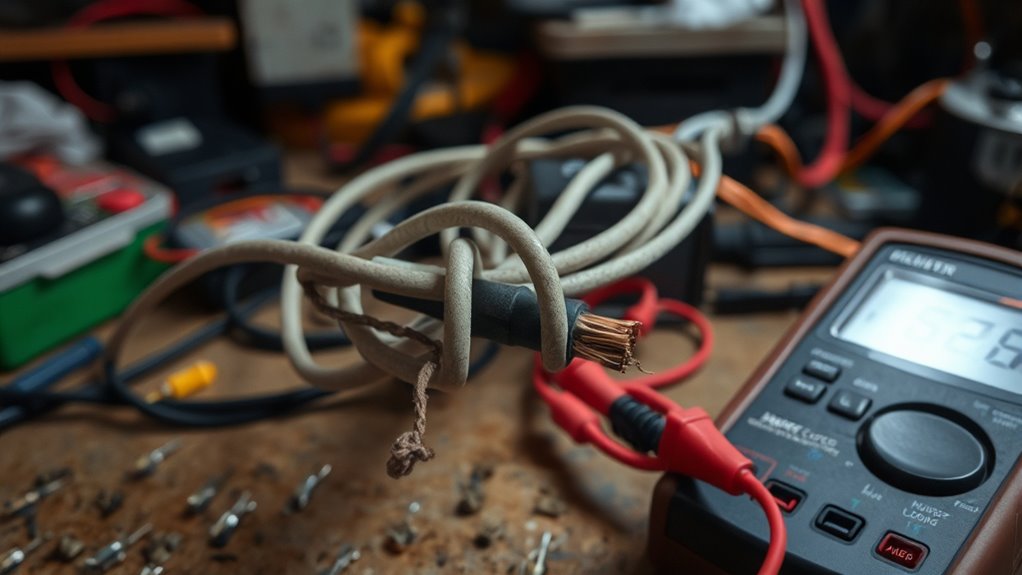
Using extension cords improperly can lead to dangerous situations, so it’s important to recognize common mistakes and avoid them. One mistake is using indoor wiring outdoors, where it’s not designed to withstand weather, increasing fire risk. Overloading extension cords beyond their capacity causes excessive heat and potential failure. Neglecting surge protection leaves your devices vulnerable to power surges, risking damage. Never daisy-chain multiple extension cords together; this can cause overheating and shorts. Also, avoid running cords under carpets or through doorways where they can be pinched or damaged. Always choose the right gauge for your load and length, and inspect cords regularly for frays or damage. Proper usage guarantees safety and maintains the integrity of your devices and wiring. Additionally, understanding voltage drop can help prevent performance issues and ensure your extension cords are functioning safely and efficiently.
Practical Examples of Voltage Drop Calculations

Understanding how to calculate voltage drop is essential to guarantee your extension cords perform safely and efficiently. Let’s look at practical examples to clarify the process. Suppose you’re powering a tool with a 15-amp draw over 50 feet of wire. Factors to consider include wire insulation type, which affects resistance, and plug compatibility to ensure proper connections. Additionally, using expert voice actors can help create instructional videos that improve understanding of electrical concepts.
Selecting the Right Extension Cord for Your Needs
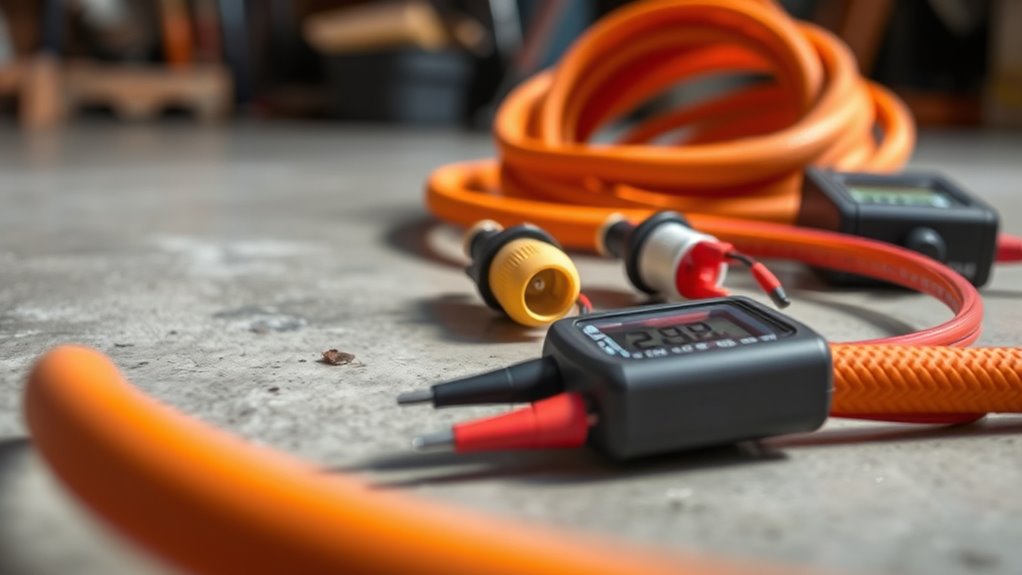
Choosing the right extension cord starts with evaluating your power needs to guarantee it can handle the load. You also need to take into account the cord’s gauge and length to prevent voltage drop and maintain safety. Keep safety tips in mind to avoid hazards and ensure reliable performance. Additionally, selecting an extension cord with appropriate safety features can further reduce risks and enhance durability.
Power Requirements Assessment
Have you ever selected an extension cord that turned out to be too weak or excessively heavy? To avoid this, assess your power requirements first. Consider the total wattage of your devices, their starting current, and how long the cord needs to be. Check the wire insulation for durability and safety, especially if it’ll be outdoors or in damp environments. Pay attention to the plug configuration to ensure compatibility with your outlets.
Key factors to evaluate include:
- Total load wattage
- Surge power needs
- Cord length and gauge
- Wire insulation quality
- Suitable plug design
Cord Gauge and Length
Selecting the right extension cord depends heavily on its gauge and length. A thicker gauge (lower AWG number) handles more current and reduces voltage drop over longer distances. When choosing, consider your power needs and how far the cord needs to reach. The cord’s insulation type matters too; durable insulation can withstand outdoor conditions and prevent electrical hazards. Shorter cords generally have less voltage drop, so opt for the shortest length possible. Additionally, the plug design influences safety and compatibility — ensure it fits snugly and matches your outlet type. Using an appropriate gauge and length prevents overheating and maintains voltage integrity. Always prioritize sturdy cord insulation and a secure plug design to ensure safe, efficient operation without risking damage or safety hazards.
Safety and Usage Tips
To guarantee safe and effective use of extension cords, it’s vital to match the cord’s gauge and length to your specific needs. Proper grounding safety ensures you prevent electrical shocks, so always choose cords with grounding prongs. Good cord management keeps cords organized and reduces tripping hazards. When selecting a cord, consider these tips:
- Use the shortest cord possible for your task
- Avoid daisy-chaining multiple extension cords
- Check for proper grounding safety features
- Keep cords away from water, heat, and sharp objects
- Regularly inspect cords for damage and replace if frayed or cracked
Safety Tips for Proper Extension Cord Usage

Using extension cords safely is essential to prevent electrical hazards and damage to your devices. Always check for proper grounding safety before use, ensuring the cord has a grounding pin. Avoid overloading cords; match the cord’s capacity to your device’s power needs. When not in use, store cords properly in a cool, dry place, coiled loosely to prevent damage. To reduce tripping hazards, keep cords out of walkways. Use cord covers if needed. Never run cords under rugs or furniture, as this can cause overheating. Here’s a quick safety reminder:
| Safety Tip | Why It Matters | Best Practice |
|---|---|---|
| Proper grounding safety | Prevents electric shock | Check for grounding pin |
| Cord storage | Preserves cord integrity | Coil loosely in a dry place |
| Avoid overloading | Prevents overheating | Match cord capacity to device |
| Keep cords visible | Prevents tripping | Use cord covers if necessary |
Frequently Asked Questions
How Do Temperature and Environmental Factors Influence Voltage Drop?
Temperature and environmental factors increase circuit resistance, which can cause higher voltage drop in your extension cords. Hotter temperatures make conductors expand, raising resistance, while cold temperatures can make insulation brittle, affecting insulation quality. Poor insulation quality worsens resistance issues, leading to more voltage drop. To minimize this, choose cords with good insulation and avoid exposing them to extreme temperatures, ensuring the voltage delivered remains stable and reliable.
Can Using Multiple Extension Cords Increase Voltage Drop Risks?
Using multiple extension cords is like adding more hurdles in a relay race; it increases wiring resistance, leading to higher power loss and greater voltage drop. This chain reaction can cause equipment to underperform or even damage. To keep things running smoothly, avoid daisy-chaining cords and opt for a single, heavy-duty extension cord designed for your device’s power needs, minimizing voltage drop risks and ensuring safety.
What Are the Signs of Excessive Voltage Drop in Devices?
If you notice power fluctuations or your devices aren’t functioning properly, these are signs of excessive voltage drop. Use voltage indicators to check if voltage levels are lower than normal at your device’s outlet. When voltage drops markedly, your device may flicker, turn off unexpectedly, or run inefficiently. Regularly monitoring with voltage indicators helps you catch these issues early, preventing possible damage and ensuring safe operation.
How Often Should Extension Cords Be Checked for Safety and Performance?
Don’t let safety fall through the cracks; you should check your extension cords at least every three to six months. Regular cord maintenance and safety inspections help catch damage or wear that could cause excessive voltage drop or hazards. If you notice fraying, cracks, or overheating, replace or repair the cord immediately. Staying vigilant guarantees your devices run smoothly and keeps you safe from electrical mishaps.
Are There Specific Standards or Regulations Governing Voltage Drop Limits?
Yes, there are specific standards and regulations governing voltage drop limits to guarantee safety and regulatory compliance. You should follow safety standards set by organizations like the National Electrical Code (NEC) and Underwriters Laboratories (UL). These standards specify acceptable voltage drop levels, typically not exceeding 3%. Adhering to these guidelines helps prevent overloading, overheating, and potential electrical hazards, ensuring your extension cords operate safely and efficiently.
Conclusion
By understanding voltage drop and how to properly size your extension cords, you prevent power loss and potential hazards. Think of your extension cord as a lifeline for your tools and appliances—if it’s too thin or too long, it struggles to deliver the needed energy, risking damage or failure. With careful calculations and safety tips, you guarantee a reliable connection, keeping your work safe and efficient like a well-oiled machine smoothly running at full power.
